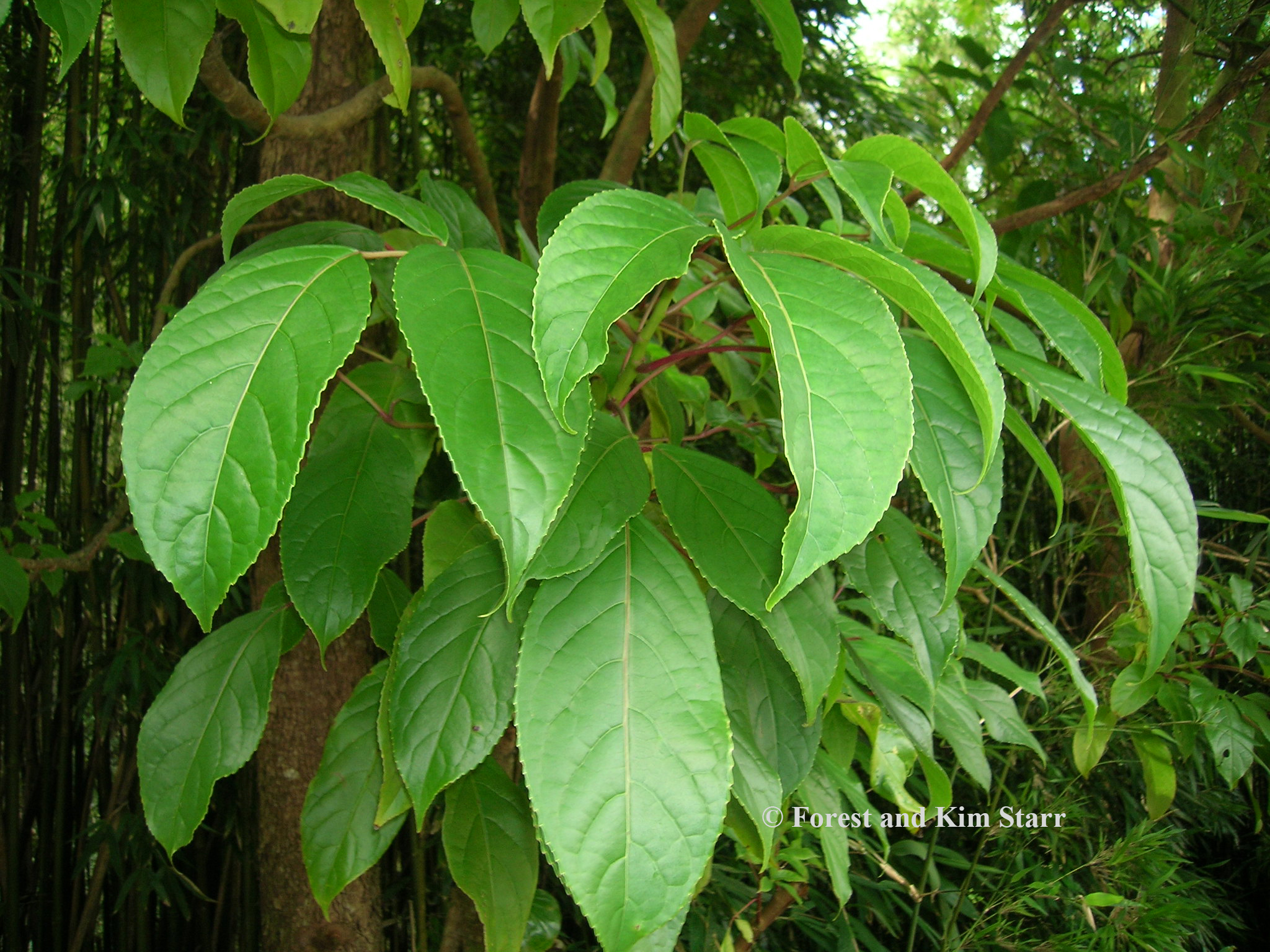ເລກລຳດັບທີ: 2638
ລະດັບການຮວບຮວມຂໍ້ມູນ: ຂໍ້ມູນພື້ນຖານ
ປັບປູງຄັ້ງລ່າສຸດ: N/A
ຕົ້ນຂົມຟາດ
Java cedar
Bischofia javanica Blume
ພືດ
ໄມ້ຢືນຕົ້ນ
ຕົ້ນໄມ້ ແລະ ປາມ
×
ຊື່ທ້ອງຖີ່ນ:
ໄທ: ຕົ້ນເຕີມ, ດູ່ສົ້ມ, ດູ່ນ້ຳ, ປາດູ່ສົ້ມ, ປຣະສົ້ມໃບສົ້ມ, ປຣະດູ່ໃບສົ້ມ, ຍາຍຕຸງັນ, ກະດັງງາດົງ, ຈັນບື, ສົ້ມກົບ, ສົ້ມກົບໃຫຍ່, ກຸຕິ, ຮຸຕິກຣອງຍັນ ແລະ ກຣອງປະຍັນ. ອັງກິດ: Java cedar ແລະ bishop’s wood.ຈີນ: 史风木, 惊呆了, 秋楓, 秋枫 ແລະ 杨牧.ມຽນມາ: aukkyu, aukkywe, hka-shatawi, kywe-tho, po-gaungsa, tayok-the, ye-padauk ແລະ yepadon. ( ໄທ: ຕົ້ນເຕີມ, ດູ່ສົ້ມ, ດູ່ນ້ຳ, ປາດູ່ສົ້ມ, ປຣະສົ້ມໃບສົ້ມ, ປຣະດູ່ໃບສົ້ມ, ຍາຍຕຸງັນ, ກະດັງງາດົງ, ຈັນບື, ສົ້ມກົບ, ສົ້ມກົບໃຫຍ່, ກຸຕິ, ຮຸຕິກຣອງຍັນ ແລະ ກຣອງປະຍັນ. ອັງກິດ: Java cedar ແລະ bishop’s wood.ຈີນ: 史风木, 惊呆了, 秋楓, 秋枫 ແລະ 杨牧.ມຽນມາ: aukkyu, aukkywe, hka-shatawi, kywe-tho, po-gaungsa, tayok-the, ye-padauk ແລະ yepadon.)
ຊື່ພ້ອງ
:
Andrachne apetala Roxb. ex Wall.
Andrachne trifoliata Roxb.
Bischofia cummingiana Decne.
Bischofia javanica var. lanceolata Müll.Arg.
Bischofia javanica var. oblongifolia (Decne.) Müll.Arg.
Bischofia javanica var. toui (Decne.) Müll.Arg.
Bischofia leptopoda Müll.Arg.
Bischofia oblongifolia Decne.
Bischofia roeperiana Decne.
Bischofia toui Decne.
Bischofia trifoliata (Roxb.) Hook.
Microelus roeperianus (Decne.) Wight & Arn.
Phyllanthus gymnanthus Baill.
Stylodiscus trifoliatus (Roxb.) Benn.
Andrachne trifoliata Roxb.
Bischofia cummingiana Decne.
Bischofia javanica var. lanceolata Müll.Arg.
Bischofia javanica var. oblongifolia (Decne.) Müll.Arg.
Bischofia javanica var. toui (Decne.) Müll.Arg.
Bischofia leptopoda Müll.Arg.
Bischofia oblongifolia Decne.
Bischofia roeperiana Decne.
Bischofia toui Decne.
Bischofia trifoliata (Roxb.) Hook.
Microelus roeperianus (Decne.) Wight & Arn.
Phyllanthus gymnanthus Baill.
Stylodiscus trifoliatus (Roxb.) Benn.
ຊື່ສະກຸນ:
Phyllanthaceae
ຊະນິດໃກ້ຄຽງ:
ບັນຍາຍລັກສະນະທາງພືດສາດ:
Trees to 40 m tall, to 2.3 m d.b.h., evergreen; stem straight, branching lower; bark gray-brown to brown, ca. 1 cm thick, with red latex; branchlets glabrous. Leaves palmately 3(-5)-foliolate; stipules membranous, lanceolate, ca. 8 mm, caducous; petiole 8-20 cm; terminal petiolule 2-5 cm, lateral petiolules 5-20 mm; leaflet blades ovate, elliptic, obovate, or elliptic-ovate, 7-15 × 4-8 cm, papery, sparsely pubescent only on nerves, glabrescent, base broadly cuneate to obtuse, margins with 2 or 3 teeth per cm, apex acute or caudate-acuminate. Plants dioecious. Inflorescence axillary, paniculate; male peduncle 8-13 cm, puberulent to glabrous, female peduncle 15-27 cm, pendent. Male flowers to 2.5 mm in diam.; sepals membranous, semiorbicular, adaxially concave, ladle-shaped, abaxially puberulent outside; filaments short; pistillode small, peltate, pubescent. Female flowers: sepals similar to male but oblong-ovate, margins membranous; ovary smooth, glabrous, 3- or 4-locular; styles 3 or 4, linear, entire. Fruits globose or subglobose, 6-13 mm in diam., brownish. Seeds oblong, ca. 5 mm
ນິເວດວິທະຍາ
ເຂດກະຈາຍພັນທົ່ວໂລກ:
N/A
ເຂດກະຈາຍພັນໃນລາວ
:
ເຂດພູສູງສາຍພູຫຼວງ ແລະ ເຂດພູພຽງແຂວງຊຽງຂວາງ
ເຂດສາຍພູຫຼວງພາກເໜືອ
ເຂດສາຍພູຫຼວງພາກເໜືອ

ເຂດກະຈາຍພັນຕາມພູມສັນຖານ
:
ສະເພາະຖິ່ນໃນລາວ:
N/A
ຮຸກຮານ
:
N/A
ສະຖານະພາບການອະນູຮັກ IUCN
:
N/A
ສະຖານະພາບການອະນຸຮັກແຫ່ງຊາດລາວ
:
N/A
ການນຳໃຊ້
ປະເພດການນຳໃຊ້:
ອາຫານ
ພືດເປັນຢາ
ສິ່ງປູກສ້າງ
ພືດເປັນຢາ
ສິ່ງປູກສ້າງ
ບັນຍາຍການນຳໃຊ້:
ເປັນອາຫານ:
- ຍອດອ່ອນ ແລະ ດອກ: ສາມາດນຳມາປະກອບອາຫານໄດ້ ເຊັ່ນ: ຍຳ, ຫຼວກກັບແຈ່ວ, ກິນສົດ ຫຼື ນຳໄປເຝົາໄຟກິນກັບເກືອຄ້າຍໝ້ຽງ, ຍອດອ່ອນຍັງສາມາດນຳມາປະກອບອາຫານເພື່ອເພີ່ມຣົດສົ້ມ ເຊັ່ນ: ແກງສົ້ມ.
- ໝາກ: ໝາກສຸກມີຣົດຊາດສົ້ມ ແລະ ຝາດ ສາມາດກິນໄດ້.
ສັບພະຄຸນ:
- ຮາກ ແລະ ເປືອກ: ເປັນຢາຟອກເລືອດ, ແກ້ເລືອດດັງອອກ, ຊ່ວຍຫຼຸດອາການບວມ, ຊ່ວຍຂັບລົມ, ແກ້ອາການເຈັບກະດູກ ແລະ ເຈັບຂໍ້ກະດູກ ໂດຍນຳມາດອງເຫຼົ້າກິນ.
- ເປືອກ: ຕົ້ມດື່ມແກ້ເຈັບຄໍ, ແກ້ເຈັບທ້ອງປິດ, ແກ້ເຈັບທ້ອງ (ເປືອກ, ໃບ), ແກ້ອາການຖອກທ້ອງ (ເປືອກ, ຍອດອ່ອນ), ແກ້ອາການທ້ອງຂີ້ຮາກ (ເປືອກ, ແກ່ນລຳຕົ້ນ) ແລະ ຊ່ວຍປ້ອງກັນອາການຖອກທ້ອງໄດ້.
- ລຳຕົ້ນ: ຕົ້ມດື່ມແກ້ເຈັບຄໍ, ແກ້ສຽງແຫບ ແລະ ແກ້ເຈັບທ້ອງບິດ.
- ເນື້ອໄມ້: ຕົ້ມດື່ມເປັນຢາບຳລຸງເລືອດ, ແກ້ເລືອດດັງໄຫຼ ແລະ ແກ້ໄຂ້ເນື່ອງຈາກເລືອດ.
- ໃບ: ແກ້ຕານເຕັ້ນໃນເດັກ, ແກ້ເຈັບອັກເສບ, ແກ້ອາການທ້ອງຂີ້ຮາກ, ແກ້ອາການເຈັບທ້ອງບິດ, ແກ້ອາການທ່ຽວຖ່າຍ, ຮັກສາມະເຮັງໃນກະເພາະອາຫານ ຫຼື ທາງເດີນໃນກະເພາະອາຫານ, ຮັກສາຕັບອັກເສບເນື່ອງຈາກໄວຣັສ ແລະ ໃຊ້ພາຍນອກໂດຍແກ້ຝີໜອງ.
- ດອກ: ຊ່ວຍຂັບເສມຫະ, ແກ້ລົມຈຸກສຽດ ແລະ ແກ້ທ້ອງອືດທ້ອງເຟີ້.
ຂໍ້ມູນທາງວິທະຍາສາດ:
- ໃບ ແລະ ຕົ້ນ: ພົບສານ Epifriedelinol acetate, Friedelinol, B-Sitosterol ແລະ B-Amyrin.
- ແກ່ນ: ພົບນ້ຳມັນ llagic acid, Ursolic acid ແລະ ພົບນ້ຳມັນຫອມທີ່ມີສີເຫຼືອງອ່ອນອີກດ້ວຍ.
ສິ່ງປຸກສ້າງ: ເນື້ອໄມ້ມີຄວາມໜຽວ ແລະ ແຂງແຮງສາມາດນຳມາສ້າງເຮືອນ, ຂົວ ແລະ ໃຊ້ເຮັດເຟີນິເຈີ້ ຫຼື ອຸປະກອນຕ່າງທີ່ທົນນ້ຳໄດ້.
ພືດປະດັບ: ສາມາດນຳມາປູກເປັນໄມ້ປະດັບເນື່ອງຈາກມີໃບທີ່ໜາ, ມີຊໍ່ດອກ ແລະ ຊໍ່ໝາກທີ່ສວຍງາມ.
ການປູກ ການລ້ຽງ:
N/A
ລະດູການເກັບກູ້:
ການຕະຫຼາດ ແລະ ຕ່ອງໂສ້ມູນຄ່າ:
N/A
ການຄຸ້ມຄອງຈັດການ
N/A
ໂພຊະນາການ
ຄຸນຄ່າທາງໂພຊະນາການ:
ບັນຍາຍຄຸນຄ່າທາງໂພຊະນາການ:
N/A
| ສານອາຫານ | /100g | ໝາຍເຫດ |
|---|---|---|
| ໂປຣຕີນ | N/A | N/A |
| ຄາໂບໄຮເດຣດ | N/A | N/A |
| ໄຂມັນ | N/A | N/A |
| ວິຕາມິນ | N/A | N/A |
| ແຮ່ທາດ | N/A | N/A |
| ເສັ້ນໄຍ | N/A | N/A |
ອ້າງອິງ
ເຄດິດຮູບພາບ:
ອ້າງອິງ:
Ajaib,M., Khan, Z.-U.-D. (2012). Bischofia javanica: A new record to the Flora of Pakistan. BIOLOGIA (PAKISTAN) 58 (1&2), 179-183.
Indra, R., Bachheti, R.K., Archana, J. (2013). Chemical composition, mineral and nutritional value of wild Bischofia javanica seed. International Food Research Journal 20(4): 1747-1751.
Chittaphone, V., Chanta, S., paly, J. (2019). A survey local food plants from forest of ban phornxay louangprabang district lao people's democratic republic. Phranakhon Rajabhat Research Journal (Science and Technology), 15(1).
van Welzen, P.C. (2016). Bischofia and Hymenocardia (Phyllanthaceae) in Malesia. Blumea 61: 272–279.
Lepcha L., Roy S.G., Basistha B.C., Sharma, N.P., Subba K.B., Gurung, R. (2013). Medicinal value and microbial VAM incidence analysis of Bischofia javanica Blume in Sikkim Himalaya, India. The Journal of Ethnobiology and Traditional Medicine, 120: 650-655.
Indra, R., Bachheti, R.K., Archana, J. (2013). Chemical composition, mineral and nutritional value of wild Bischofia javanica seed. International Food Research Journal 20(4): 1747-1751.
Chittaphone, V., Chanta, S., paly, J. (2019). A survey local food plants from forest of ban phornxay louangprabang district lao people's democratic republic. Phranakhon Rajabhat Research Journal (Science and Technology), 15(1).
van Welzen, P.C. (2016). Bischofia and Hymenocardia (Phyllanthaceae) in Malesia. Blumea 61: 272–279.
Lepcha L., Roy S.G., Basistha B.C., Sharma, N.P., Subba K.B., Gurung, R. (2013). Medicinal value and microbial VAM incidence analysis of Bischofia javanica Blume in Sikkim Himalaya, India. The Journal of Ethnobiology and Traditional Medicine, 120: 650-655.
ຜູ້ສ້າງ Factsheet:
ຜູ້ກວດສອບ Factsheet:
,
